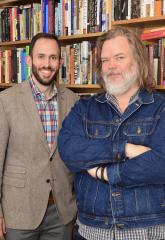
Drs. Hunter Hampton, left, and Court Carney, two faculty members in Stephen F. Austin State University’s Department of History, incorporated new media into the senior capstone course by challenging students to create their own public history podcasts. Their innovative team-taught method for this course was recently recognized with a Bright Spot award from the SFA Faculty Senate, the Center for Teaching and Learning, and the SFA vice presidents.
This past fall, two faculty members in Stephen F. Austin State University’s Department of History utilized new media to team teach the senior capstone course by introducing podcasts into the program.
“Podcasts are a growing medium that encourages students to consider audience engagement beyond the professor reading a paper and stuffing it in a desk drawer,” Dr. Hunter Hampton, lecturer of history, said.
Hampton and Dr. Court Carney, professor of history, assigned students the task of producing podcasts based on original research. This project introduced history students to public history, or how historians present the past to the public, and it helped them gain skills using new media.
The duo agreed that producing the podcasts required the same components as writing a successful history paper: primary sources, argument, context and narrative.
“We wanted to do something a bit unexpected that would still maintain the integrity of a research-intensive senior capstone class,” Carney said. “This project required students to choose a research topic that had appeal to a larger audience, and it pushed the students to sharpen their communication skills as they worked to bring their research to a nonacademic audience.”
Hampton said it took a while for the students to settle in to a course that was taught by two instructors simultaneously, but once they began to understand the assignment and what was expected, the students’ podcast projects began to take shape.
“As a teacher, I believe it is important for students to understand the past and engage the present. This project gave them the opportunity to think about how to communicate the value of their history project in a way that would involve the public,” Hampton said.
Hampton and Carney’s innovative teaching method was recently honored with a Bright Spot award from the SFA Faculty Senate, the Center for Teaching and Learning, and the SFA vice presidents. Hampton and Carney said that moving forward, they plan to look for more opportunities to team teach.
“The team-taught element of the course created a real energy in the classroom, so we are already looking for new ways to incorporate that structure into future courses,” Carney said. “I think it’s a great thing to emphasize here at SFA, especially for interdisciplinary courses.”
For more information on the Department of History, visit sfasu.edu/history.
By Emily Brown, marketing communications specialist from Stephen F. Austin State University.



